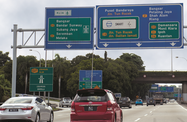The budget airline market in Malaysia is continuing to evolve. A new entrant, Malindo Air, is challenging the dominant player, AirAsia, as the latter plans an initial public offering (IPO) for its long-haul division and is facing delays at Kuala Lumpur’s new low-cost airport.
A joint venture between Malaysia’s National Aerospace and Defence Industries (51%) and rising Indonesian budget carrier Lion Air (49%), Malindo Air launched operations in March 2013 with flights between Kuala Lumpur International Airport (KLIA) and Kota Kinabalu, the capital of the state of Sabah. The airline has since added flights between KLIA and Kuching, the capital of the state of Sarawak, and it hopes to cover 12 destinations by the end of 2013.
As of mid-June, the company was already offering ten routes, including to Kuala Lumpur, Kuching and Kota Kinabalu; Johor Bahru, in southern Peninsular Malaysia, to the north of Singapore; Kota Bharu, in the north-east of Peninsular Malaysia; Miri and Sibu in Sarawak; Subang, near Kuala Lumpur; Tawau in Sabah; and Penang, on the island of the same name, which is a centre for business and tourism in north-west Malaysia. The links to Sarawak are likely to be widely welcomed, as its tourism sector has high potential but relatively limited development due to poor connectivity.
Malindo Air’s first international link, New Delhi, is expected to be one of the next destinations from KLIA, and is set to be followed by one or more cities in southern China, with Guangzhou, Hong Kong, Shenzhen and Kunming all on the radar, according to Malindo Air’s CEO, Chandran Ramamurthy. Press reports suggest that Kochi and Trichy in India may also be targets – as they are already well-performing routes for AirAsia – as well as Singapore and even Jakarta, which are currently served by Lion Air itself.
Malindo Air has said that it will be able to attract customers from budget airlines, such as AirAsia, as well as from full-service carriers, such as Malaysia Airlines, by providing amenities like hot meals, but all at low fares. Indeed, Malindo Air bills itself as “Not Just Low Cost” and offers more perks than most budget airlines, including free luggage up to 15 kg, free snacks and in-flight entertainment, as well as business class, which may appeal to some travellers currently flying in economy-only cabins of its budget rivals.
The shot of competition that Malindo Air has brought to the market has already brought down prices; flights from KLIA to Kuching and Kota Kinabalu fell 18.6% and 12.6%, respectively, between March 2013 and May 2013, according to travel website Skyscanner, as reported by the local press.
Still, these are very early days for Malindo Air – which was barely a concept this time last year – so making hard and fast predictions about its effect on the airline market in Malaysia and the wider region is difficult. Certainly, the new airline’s swift emergence will be watched closely by AirAsia, which has recently seen stellar success in expanding across the region and already has a fleet of 124 planes. Despite its geographical reach, 80% of the carrier’s profits still come from Malaysia, driving group-operating profit margins to 19.5% – fairly fat by airline industry standards. The company’s profits fell 39% in the first quarter of 2013, partly due to higher financing costs.
AirAsia owner Tony Fernandes and the CEO of the company’s Malaysian operations, Aireen Omar, have both played down the competition that Malindo Air poses, and Omar told the Malaysian National News Agency that the airline is on target for network expansion. AirAsia X, the long-haul division of the carrier, launched an up-to-$370m IPO in early June, saying that it would use the funds to finance the purchase of new planes.
But the budget airline faces challenges besides Malindo Air, including delays in the construction of the new international terminal, KLIA2, which will replace the Low Cost Carrier Terminal (LCCT) at KLIA and is expected to handle about 45m passengers each year. In January 2013 the government had said the facility would open on June 28 of the same year, but in May, Malaysia Airports Holding, the operator of the airport, said that it would be indefinitely delayed and gave no new opening date. AirAsia has since called for the establishment of an independent entity to review progress on the project, as well as to determine a completion date and the estimated cost.
For now, AirAsia will continue operating out of LCCT, which is not used by Malindo Air. The latter flies from KLIA’s main terminal building, generally considered more convenient for making international connections, providing one reason for customers to choose the upstart over its more established rival.

